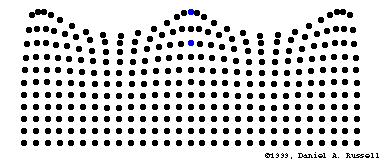Forest EngPhys 1
Physics for Scientists and Engineers
Class Policies
Syllabus
Virtual Demos
Chapt 15 Waves
http://english.ioa.cas.cn/rs/psk/200907/t20090708_22097.html
Longitudinal Waves
In a longitudinal wave the particle displacement is parallel to the direction of wave propagation. The animation below shows a one-dimensional longitudinal plane wave propagating down a tube. The particles do not move down the tube with the wave; they simply oscillate back and forth about their individual equilibrium positions. Pick a single particle and watch its motion. The wave is seen as the motion of the compressed region (ie, it is a pressure wave, sound wave), which moves from left to right.
Tansverse Waves
In a transverse wave the particle displacement is perpendicular to the direction of wave propagation. The animation below shows a one-dimensional transverse plane wave propagating from left to right. The particles do not move along with the wave; they simply oscillate up and down about their individual equilibrium positions as the wave passes by.
Water Waves
Water waves are an example of waves that involve a combination of both longitudinal and transverse motions. As a wave travels through the waver, the particles travel in clockwise circles. The radius of the circles decreases as the depth into the water increases. The movie below shows a water wave travelling from left to right in a region where the depth of the water is greater than the wavelength of the waves. I have identified two particles in blue to show that each particle indeed travels in a clockwise circle as the wave passes.


